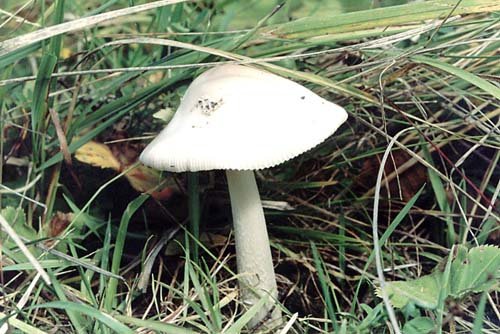White float (Amanita vaginata var. alba)
- Поделба: базидиомикота (базидиомицети)
- Поделба: Агарикомикотина (Агарикомицети)
- Класа: агарикомицети (агарикомицети)
- Подкласа: Agaricomycetidae (Агарикомицети)
- Ред: Agaricales (агаричен или ламеларен)
- Семејство: Amanitaceae (Amanitaceae)
- Род: Amanita (Amanita)
- тип: Amanita vaginata var. alba (Float white)
:
- Agaricus обвиткан var. бело
- Amanita dawn (застарен)
- Amanitopsis albida (застарен)
- Amanitopsis vaginata var. alba (застарен)

Float grey, shape white, as the name suggests, is an albino form of the gray float – Amanita vaginata.
The main features, respectively, are very close to the main form, the main difference is color.
Like all floats, a young fungus develops under the protection of a common coverlet, which, torn, remains at the base of the stem in the form of a small bag – volva.
глава: 5-10 centimeters, under favorable conditions – up to 15 cm. Ovate, then bell-shaped, later prostrate, with a thin ribbed edge. White, sometimes dirty white, no other shades, only white. Pieces of the common bedspread may remain on the skin.
Евиденција: white, thick, wide, loose.
спори во прав: бело.
Спорови: 10-12 microns, rounded, smooth.
нога: 8-15, sometimes up to 20 centimeters high and up to 2 cm in diameter. White. Central, cylindrical, even, smooth, at the base it may be slightly expanded and pubescent or covered with thin white scales. Fibrous, hollow.
прстен: absent, completely, even in young specimens, there are no traces of the ring.
Volvo: free, large, white inside and out, usually well visible, although sunk into the ground.
Евтини: thin, fragile, brittle, white or whitish. On a cut and a break, the color does not change.
Мирис: not pronounced or weak mushroom, without unpleasant shades.
Вкус: without much taste, mild, sometimes described as a mild mushroom, without bitterness and unpleasant associations.
The mushroom is considered edible, with low nutritional qualities (the pulp is thin, there is no taste). It can be eaten after a single short boil, suitable for frying, you can salt and marinate.
The white float grows from mid-summer (June) to mid-autumn, September-October, with warm autumn – until November, in deciduous and mixed forests, on fertile soils. Forms mycorrhiza with birch. It is not common, noted throughout Europe, more – in the northern regions, including our country, Belarus, the middle and northern European part of the Federation.
The float is gray, the form is white (albino) similar to the albino forms of other types of floats, and it is not possible to distinguish them “by eye”. Although it needs to be clarified here that albino forms of other floats are extremely rare and practically not described.
Слични видови вклучуваат:
Snow-white float (Amanita nivalis) – contrary to the name, this species is not snow-white at all, the hat in the center is grayish, brownish or with a light ocher tint.
Pale grebe (Amanita phalloides) in her light-colored form
Аманита верна (Аманита верна)
Аманита вироса (Аманита вироса)
Of course, these (and other light) fly agarics differ from floats in the presence of a ring. But! In adult mushrooms, the ring may already be destroyed. And at the “embryo” stage, while the fungus has not yet completely crawled out of the common cover (egg), you need to know where to look in order to determine the presence or absence of a private cover. Amanitas are generally larger, “fleshy”, but this is a very unreliable sign, since it strongly depends on the weather and the growth conditions of a particular fungus.
Recommendations: I want to say something in the style of “do not collect white floats for food”, but who will listen? Therefore, let’s put it this way: do not pick up mushrooms thrown by someone, even if they look very much like a white (and snow-white) float, since you cannot determine with certainty whether the notorious ring on the leg was there. Do not collect egg-stage amanites, even if these embryos are found near a precise, undeniable bobber.









